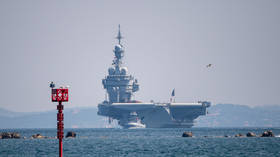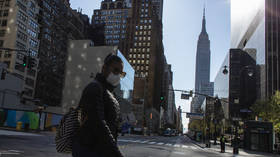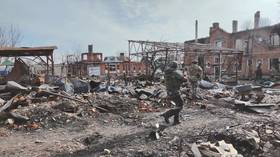‘Floating petri dishes of disease’: How on earth are cruise liners STILL at sea, MONTHS after Covid-19 struck, killing dozens?
More than 6,000 people are stuck at sea on ships, some of which set off as late as last month. Now there are criminal investigations and lawsuits underway, accusing blundering cruise firms of corporate manslaughter.
Back in 2017, when humour was still a thing, American comedian Bill Burr made a caustic suggestion as to how we could prevent global environmental collapse, by “thinning out the herd” of humanity.
“I would randomly sink cruise ships,” he insisted, straight-faced. “You get 2,500 to 3,000 people to whack, and I think it’s a good mix of people to get rid of.”
No-one is laughing about cruise ship passengers dying now, of course – at one stage a quarter of all coronavirus deaths in Australia, for example, came from a single ship, the Ruby Princess – but there is definitely something funny-peculiar about the fact that so many people were still ambling onto these giant, floating virus buffets in March, even after the Diamond Princess debacle in Japan.
On February 1, this ship, owned by Carnival Cruises, was advised that a passenger who had recently disembarked in Hong Kong was being treated for Covid-19. It was almost two full days before the passengers and crew were informed of the danger, and two more days until they were quarantined in their cabins.
While it is impossible to know how much the disease spread during that hiatus, as guests hung out in saunas and ate cheek by jowl, what we do know is that more than 700 people ended up infected. At one stage, the Diamond Princess accounted for more than half the world’s cases outside of China.
Terrified passengers and staff were trapped on the ship – many in windowless cabins – as it remained docked in Yokohama for weeks, and 12 people eventually died.
Then on March 5th, just four days after the final crew member was evacuated from the Diamond Princess, coronavirus tests were being dropped by helicopter onto its sister ship the Grand Princess, off the coast of California.
Frighteningly, 21 of the first 46 people tested were positive, and President Trump was soon suggesting the entire ship should be prevented from disembarking. “I don’t need to have the numbers double because of one ship,” he said – and nearly 2,000 passengers were eventually quarantined on US military bases.
And yet, despite a tidal wave of ominous stories about cruise ships becoming petri dishes for the virus, 2,647 people piled onto another Carnival ship, the Ruby Princess, in Sydney Harbour on March 8th, for what would become the most ill-fated voyage since the Titanic.
That same day, the Centers for Disease Control in Atlanta issued a public advisory to “defer all cruise ship travel, worldwide.” Carnival Cruise Line spokesman Roger Frizzell later pointed out that the company was under no legal obligation to follow that recommendation. “The advisory is not an edict,” he said.
Despite how aware the world was of the virus’s infectiousness, Ruby’s crew had just 12 hours to properly clean a vessel that would be as tall as a 70-storey building if parked vertically.
Let’s all do the corona conga
One passenger, Stacie Hunt, 36, says she realised “things were serious” before they even got on the boat. “At the end of the day, we knew what was going on around the world. We knew how quickly it spread in ships,” she said. “People just didn’t care.”
The Ruby Princess sailed to New Zealand (one of its stops there, in Napier, left behind a cluster of 19 virus cases) and then raced back to Sydney three days ahead of schedule as global authorities began to crack down on ship arrivals.
Despite the fact that doctors on board had already reported sick passengers to authorities, video later emerged of a conga line of kitchen staff dancing through a packed dining room on the last night of the voyage. Authorities would later announce that it was likely a “crew member working in the galley” had started the spread of the virus.
Cruise ships always arrive in Sydney Harbour at dawn, to make the most of its majesty, but the Ruby Princess docked at 2am on March 19th. Three ambulances were waiting on the dock to collect stricken passengers.
The circumstances surrounding exactly how the rest of those on board were allowed to waltz off and board domestic and international flights – rather than being quarantined – is now the subject of a criminal investigation by the Australian police, alongside a Special Commission of Inquiry.
More than 600 of the voyage’s passengers have since been diagnosed with coronavirus, making it the biggest individual contributor to Australia’s Covid-19 numbers, and 19 people have died.
Passengers from the ship have also taken the virus to Canada, America and the UK, and lawsuits have been lodged in the US against the operator of the Ruby Princess, alleging officials took a “lackadaisical approach” to safety.
Graeme Lake and his wife Karla took the cruise to celebrate her 75th birthday, but both contracted the virus during the trip and she later died. Graeme says passengers were never told they were at risk, and has vowed to seek justice for his beloved partner.
“They made a point of not letting anyone know at all that anyone was sick,” he told Australia’s Seven Television. “Good as gold, we thought, it’s fine.”
Armageddon out of here
Incredibly this week, while the boat – effectively a crime scene – is still quarantined off the coast of Australia, with more than 1,000 crew on board, including 140 active coronavirus cases, American Jan Swartz, the president of Carnival Cruises – which has seen its share price fall 75 percent this year – appeared in a video to announce that the company “remains optimistic that Emerald and Ruby Princess will still be able to offer roundtrip cruises from Seattle to Alaska in the late summer.”
Carnival has now finally cancelled all of its cruises through late June, and some through the end of the year. The company’s chief experience officer declared: “The cruise space is as bad as it gets. It’s armageddon.”
What does seem alarming is how long the company had known that armageddon was approaching, and the fact that it continued to put both its customers and its staff in harm’s way. Aside from the Ruby, Diamond and Grand Princesses, at least seven more of the Carnival Line’s ships have become virus hot spots, resulting in more than 1,500 positive infections and at least 39 fatalities.
As of April 9, there were still more than 6,000 passengers at sea on various ships, and some of them may not be able to disembark until the end of April. Clearly, the death toll is yet to be finalised.
Carnival’s innovation chief, John Padgett, had been dealing with a manufacturer based in Wuhan and has said that he was made aware of the scale of the coronavirus outbreak in late January. “The biggest thing about that, it’s a learning I don’t think I’ll ever forget… is that we actually had insight into the global situation much earlier than most,” Padgett revealed.
And yet so little was done, not just by Carnival but the entire industry, as University of Chicago epidemiologist Katelyn Gostic points out: “The cruise ship response was definitely lagging behind expert opinion on how big the risks are,” she told Washington Post. “It was sluggish decision-making, and they should have responded earlier.”
Also on rt.com Cruise ships ordered by US Coast Guard to remain at sea & prepare to treat coronavirus-stricken passengers themselvesCarry on cruising?
Cruising has sailed through tumultuous PR waters before, most notably with the capsizing of the Costa Concordia in Italy in 2012, which killed 32 people. A year later, passengers endured the so-called ‘Poop Cruise’ on the Carnival Triumph, after a fire on board led to the ship being stuck at sea for a week with overflowing toilets and hallways flooded with human waste.
Despite the lingering stench, Carnival was offering cruises on the same ship just two months later.
No-one died, then, of course, so surely the tsunami of bad publicity that has washed over cruise ships globally will prove more damaging this time around?
The industry, which normally carries 30 million people a year, clearly does not think so, with Carnival offering bookings on cruises to Asia on its Diamond Princess as soon as October this year.
Despite a Yahoo poll finding that 83 percent of Australians would not travel on a cruise ship again for fear of catching an infection, 17 percent still said they would. Another poll, on Cruise Critic, found that 75 percent of respondents planned to cruise “as much as” or “even more,” as soon as ships start sailing again.
Incredibly, future cruise sales have surged over the past month, with online portal CruiseCompete.com reporting a 40 percent increase in 2021 bookings compared to 2019.
And even those people who have had to cancel cruises that would possibly have seen them infected are keen to get back on board, with as many as three quarters of cancellations taking a future credit of 125 percent of their cruise value rather than a 100 percent refund.
Perhaps sinking a few ships, as Burr suggested, might be the only way to save people from themselves.
Think your friends would be interested? Share this story!
The statements, views and opinions expressed in this column are solely those of the author and do not necessarily represent those of RT.
















